 |
Guidelines for OpenVMS Cluster Configurations
8.2.4 Related Software Products
Table 8-3 shows a variety of related OpenVMS Cluster software
products that Compaq offers to increase availability.
Table 8-3 Products That Increase Availability
| Product |
Description |
|
DECamds
|
Collects and analyzes data from multiple nodes simultaneously and
directs all output to a centralized DECwindows display. The analysis
detects availability problems and suggests corrective actions.
|
|
Volume Shadowing for OpenVMS
|
Makes any disk in an OpenVMS Cluster system a redundant twin of any
other same-size disk (same number of physical blocks) in the OpenVMS
Cluster.
|
|
DECevent
|
Simplifies disk monitoring. DECevent notifies you when it detects that
a disk may fail.
|
8.3 Strategies for Configuring Highly Available OpenVMS Clusters
The hardware you choose and the way you configure it has a significant
impact on the availability of your OpenVMS Cluster system. This section
presents strategies for designing an OpenVMS Cluster configuration that
promotes availability.
8.3.1 Availability Strategies
Table 8-4 lists strategies for configuring a highly available
OpenVMS Cluster. These strategies are listed in order of importance,
and many of them are illustrated in the sample optimal configurations
shown in this chapter.
Table 8-4 Availability Strategies
| Strategy |
Description |
|
Eliminate single points of failure
|
Make components redundant so that if one component fails, the other is
available to take over.
|
|
Shadow system disks
|
The system disk is vital for node operation. Use Volume Shadowing for
OpenVMS to make system disks redundant.
|
|
Shadow essential data disks
|
Use Volume Shadowing for OpenVMS to improve data availability by making
data disks redundant.
|
|
Provide shared, direct access to storage
|
Where possible, give all nodes shared direct access to storage. This
reduces dependency on MSCP server nodes for access to storage.
|
|
Minimize environmental risks
|
Take the following steps to minimize the risk of environmental problems:
- Provide a generator or uninterruptible power system (UPS) to
replace utility power for use during temporary outages.
- Configure extra air-conditioning equipment so that failure of a
single unit does not prevent use of the system equipment.
|
|
Configure at least three nodes
|
OpenVMS Cluster nodes require a quorum to continue operating. An
optimal configuration uses a minimum of three nodes so that if one node
becomes unavailable, the two remaining nodes maintain quorum and
continue processing.
Reference: For detailed information on quorum
strategies, see Section 11.5 and OpenVMS Cluster Systems.
|
|
Configure extra capacity
|
For each component, configure at least one unit more than is necessary
to handle capacity. Try to keep component use at 80% of capacity or
less. For crucial components, keep resource use sufficiently
less than 80% capacity so that if one component fails, the
work load can be spread across remaining components without overloading
them.
|
|
Keep a spare component on standby
|
For each component, keep one or two spares available and ready to use
if a component fails. Be sure to test spare components regularly to
make sure they work. More than one or two spare components increases
complexity as well as the chance that the spare will not operate
correctly when needed.
|
|
Use homogeneous nodes
|
Configure nodes of similar size and performance to avoid capacity
overloads in case of failover. If a large node fails, a smaller node
may not be able to handle the transferred work load. The resulting
bottleneck may decrease OpenVMS Cluster performance.
|
|
Use reliable hardware
|
Consider the probability of a hardware device failing. Check product
descriptions for MTBF (mean time between failures). In general, newer
technologies are more reliable.
|
8.4 Strategies for Maintaining Highly Available OpenVMS Clusters
Achieving high availability is an ongoing process. How you manage your
OpenVMS Cluster system is just as important as how you configure it.
This section presents strategies for maintaining availability in your
OpenVMS Cluster configuration.
8.4.1 Strategies for Maintaining Availability
After you have set up your initial configuration, follow the strategies
listed in Table 8-5 to maintain availability in OpenVMS Cluster
system.
Table 8-5 Strategies for Maintaining Availability
| Strategy |
Description |
|
Plan a failover strategy
|
OpenVMS Cluster systems provide software support for failover between
hardware components. Be aware of what failover capabilities are
available and which can be customized for your needs. Determine which
components must recover from failure, and make sure that components are
able to handle the additional work load that may result from a failover.
Reference: Table 8-2 lists OpenVMS Cluster
failover mechanisms and the levels of recovery that they provide.
|
|
Code distributed applications
|
Code applications to run simultaneously on multiple nodes in an OpenVMS
Cluster system. If a node fails, the remaining members of the OpenVMS
Cluster system are still available and continue to access the disks,
tapes, printers, and other peripheral devices that they need.
|
|
Minimize change
|
Assess carefully the need for any hardware or software change before
implementing it on a running node. If you must make a change, test it
in a noncritical environment before applying it to your production
environment.
|
|
Reduce size and complexity
|
After you have achieved redundancy, reduce the number of components and
the complexity of the configuration. A simple configuration minimizes
the potential for user and operator errors as well as hardware and
software errors.
|
|
Set polling timers identically on all nodes
|
Certain system parameters control the polling timers used to maintain
an OpenVMS Cluster system. Make sure these system parameter values are
set identically on all OpenVMS Cluster member nodes.
Reference: For information about these system
parameters, see OpenVMS Cluster Systems.
|
|
Manage proactively
|
The more experience your system managers have, the better. Allow
privileges for only those users or operators who need them. Design
strict policies for managing and securing the OpenVMS Cluster system.
|
|
Use AUTOGEN proactively
|
With regular AUTOGEN feedback, you can analyze resource usage that may
affect system parameter settings.
|
|
Reduce dependencies on a single server or disk
|
Distributing data across several systems and disks prevents one system
or disk from being a single point of failure.
|
|
Implement a backup strategy
|
Performing frequent backup procedures on a regular basis guarantees the
ability to recover data after failures. None of the strategies listed
in this table can take the place of a solid backup strategy.
|
8.5 Availability in a LAN OpenVMS Cluster
Figure 8-1 shows an optimal configuration for a small-capacity,
highly available LAN OpenVMS Cluster system. Figure 8-1 is followed
by an analysis of the configuration that includes:
- Analysis of its components
- Advantages and disadvantages
- Key availability strategies implemented
Figure 8-1 LAN OpenVMS Cluster System
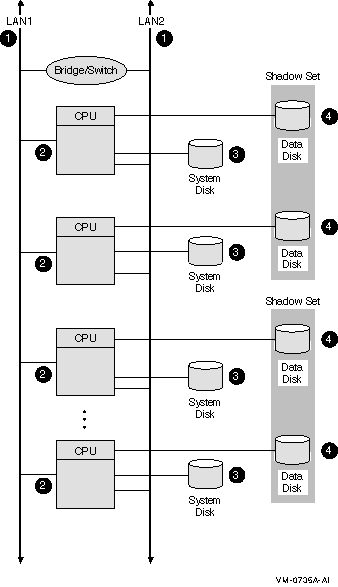
8.5.1 Components
The LAN OpenVMS Cluster configuration in Figure 8-1 has the
following components:
| Component |
Description |
|
1
|
Two Ethernet interconnects. For higher network capacity, use FDDI
interconnects instead of Ethernet.
Rationale: For redundancy, use at least two LAN
interconnects and attach all nodes to all LAN interconnects.
A single interconnect would introduce a single point of failure.
|
|
2
|
Three to eight Ethernet-capable OpenVMS nodes.
Each node has its own system disk so that it is not dependent on
another node.
Rationale: Use at least three nodes to maintain
quorum. Use fewer than eight nodes to avoid the complexity of managing
eight system disks.
Alternative 1: If you require satellite nodes,
configure one or two nodes as boot servers. Note, however, that the
availability of the satellite nodes is dependent on the availability of
the server nodes.
Alternative 2: For more than eight nodes, use a LAN
OpenVMS Cluster configuration as described in Section 8.10.
|
|
3
|
System disks.
System disks generally are not shadowed in LAN OpenVMS Clusters
because of boot-order dependencies.
Alternative 1: Shadow the system disk across two local
controllers.
Alternative 2: Shadow the system disk across two
nodes. The second node mounts the disk as a nonsystem disk.
Reference: See Section 11.2.4 for an explanation of
boot-order and satellite dependencies.
|
|
4
|
Essential data disks.
Use volume shadowing to create multiple copies of all essential
data disks. Place shadow set members on at least two nodes to eliminate
a single point of failure.
|
8.5.2 Advantages
This configuration offers the following advantages:
- Lowest cost of all the sample configurations shown in this chapter.
- Some potential for growth in size and performance.
- The LAN interconnect supports the widest choice of nodes.
8.5.3 Disadvantages
This configuration has the following disadvantages:
- No shared direct access to storage. The nodes are dependent on an
MSCP server for access to shared storage.
- Shadowing disks across the LAN nodes causes shadow copies when the
nodes boot.
- Shadowing the system disks is not practical because of boot-order
dependencies.
8.5.4 Key Availability Strategies
The configuration in Figure 8-1 incorporates the following
strategies, which are critical to its success:
- This configuration has no single point of failure.
- Volume shadowing provides multiple copies of essential data disks
across separate nodes.
- At least three nodes are used for quorum, so the OpenVMS Cluster
continues if any one node fails.
- Each node has its own system disk; there are no satellite
dependencies.
8.6 Configuring Multiple LANs
Follow these guidelines to configure a highly available multiple LAN
cluster:
- Bridge LAN segments together to form a single extended LAN.
- Provide redundant LAN segment bridges for failover support.
- Configure LAN bridges to pass the LAN and MOP multicast messages.
Reference: Refer to the documentation for your LAN
bridge and to the documentation for RBMS, DECelms, or POLYCENTER
Framework for more information about configuring LAN bridges to pass
these multicast messages.
- Use the Local Area OpenVMS Cluster Network Failure Analysis Program
to monitor and maintain network availability. (See OpenVMS Cluster Systems for
more information.)
- Use the troubleshooting suggestions in OpenVMS Cluster Systems to diagnose
performance problems with the SCS layer and the NISCA transport
protocol.
- Keep LAN average utilization below 50%.
Reference: See Section 10.7.7 for information about
extended LANs (ELANs).
8.6.1 Selecting MOP Servers
When using multiple LAN adapters with multiple LAN segments, distribute
the connections to LAN segments that provide MOP service. The
distribution allows MOP servers to downline load satellites even when
network component failures occur.
It is important to ensure sufficient MOP servers for both VAX and Alpha
nodes to provide downline load support for booting satellites. By
careful selection of the LAN connection for each MOP server (Alpha or
VAX, as appropriate) on the network, you can maintain MOP service in
the face of network failures.
8.6.2 Configuring Two LAN Segments
Figure 8-2 shows a sample configuration for an OpenVMS Cluster
system connected to two different LAN segments. The configuration
includes Alpha and VAX nodes, satellites, and two bridges.
Figure 8-2 Two-LAN Segment OpenVMS Cluster
Configuration
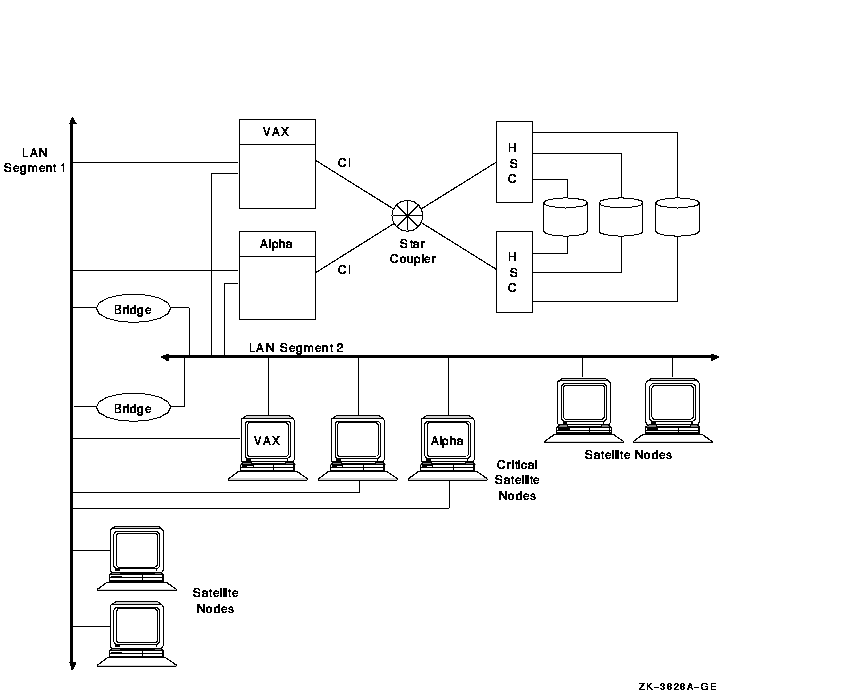
The figure illustrates the following points:
- Connecting critical nodes to multiple LAN segments provides
increased availability in the event of segment or adapter failure. Disk
and tape servers can use some of the network bandwidth provided by the
additional network connection. Critical satellites can be booted using
the other LAN adapter if one LAN adapter fails.
- Connecting noncritical satellites to only one LAN segment helps to
balance the network load by distributing systems equally among the LAN
segments. These systems communicate with satellites on the other LAN
segment through one of the bridges.
- Only one LAN adapter per node can be used for DECnet and MOP
service to prevent duplication of LAN addresses.
- LAN adapters providing MOP service (Alpha or VAX, as appropriate)
should be distributed among the LAN segments to ensure that LAN
failures do not prevent satellite booting.
- Using redundant LAN bridges prevents the bridge from being a
single point of failure.
8.6.3 Configuring Three LAN Segments
Figure 8-3 shows a sample configuration for an OpenVMS Cluster
system connected to three different LAN segments. The configuration
also includes both Alpha and VAX nodes and satellites and multiple
bridges.
Figure 8-3 Three-LAN Segment OpenVMS Cluster
Configuration
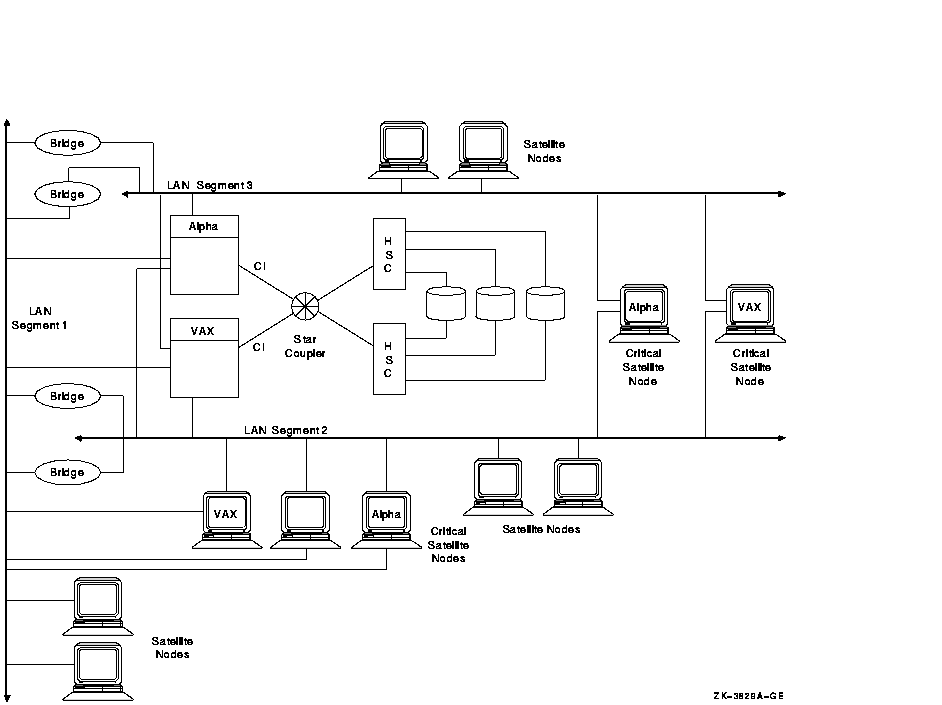
The figure illustrates the following points:
- Connecting disk and tape servers to two or three LAN segments can
help provide higher availability and better I/O throughput.
- Connecting critical satellites to two or more LAN segments can
also increase availability. If any of the network components fails,
these satellites can use the other LAN adapters to boot and still have
access to the critical disk servers.
- Distributing noncritical satellites equally among the LAN segments
can help balance the network load.
- A MOP server (Alpha or VAX, as appropriate) is provided for each
LAN segment.
Reference: See Section 11.2.4 for more information
about boot order and satellite dependencies in a LAN. See OpenVMS Cluster Systems
for information about LAN bridge failover.
8.7 Availability in a DSSI OpenVMS Cluster
Figure 8-4 shows an optimal configuration for a medium-capacity,
highly available DSSI OpenVMS Cluster system. Figure 8-4 is followed
by an analysis of the configuration that includes:
- Analysis of its components
- Advantages and disadvantages
- Key availability strategies implemented
Figure 8-4 DSSI OpenVMS Cluster System
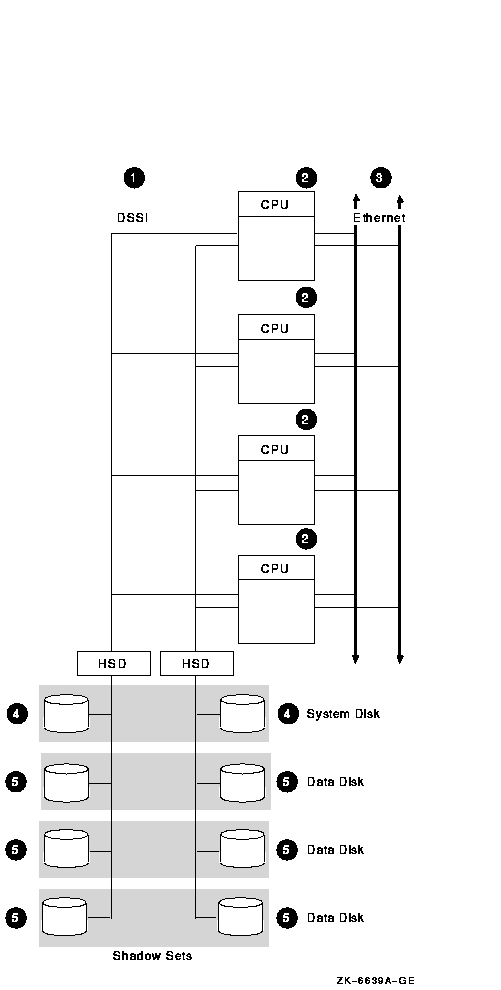
8.7.1 Components
The DSSI OpenVMS Cluster configuration in Figure 8-4 has the
following components:
| Part |
Description |
|
1
|
Two DSSI interconnects with two DSSI adapters per node.
Rationale: For redundancy, use at least two
interconnects and attach all nodes to all DSSI interconnects.
|
|
2
|
Two to four DSSI-capable OpenVMS nodes.
Rationale: Three nodes are recommended to maintain
quorum. A DSSI interconnect can support a maximum of four OpenVMS nodes.
Alternative 1: Two-node configurations require a
quorum disk to maintain quorum if a node fails.
Alternative 2: For more than four nodes, configure two
DSSI sets of nodes connected by two LAN interconnects.
|
|
3
|
Two Ethernet interconnects.
Rationale: The LAN interconnect is required for
DECnet--Plus communication. Use two interconnects for redundancy. For
higher network capacity, use FDDI instead of Ethernet.
|
|
4
|
System disk.
Shadow the system disk across DSSI interconnects.
Rationale: Shadow the system disk across interconnects
so that the disk and the interconnect do not become single points of
failure.
|
|
5
|
Data disks.
Shadow essential data disks across DSSI interconnects.
Rationale: Shadow the data disk across interconnects
so that the disk and the interconnect do not become single points of
failure.
|
8.7.2 Advantages
The configuration in Figure 8-4 offers the following advantages:
- The DSSI interconnect gives all nodes shared, direct access to all
storage.
- Moderate potential for growth in size and performance.
- There is only one system disk to manage.
8.7.3 Disadvantages
This configuration has the following disadvantages:
- Applications must be shut down in order to swap DSSI cables. This
is referred to as "warm swap." The DSSI cable is warm
swappable for the adapter, the cable, and the node.
- A node's location on the DSSI affects the recoverability of the
node. If the adapter fails on a node located at the end of the DSSI
interconnect, the OpenVMS Cluster may become unavailable.
8.7.4 Key Availability Strategies
The configuration in Figure 8-4 incorporates the following
strategies, which are critical to its success:
- This configuration has no single point of failure.
- Volume shadowing provides multiple copies of system and essential
data disks across separate DSSI interconnects.
- All nodes have shared, direct access to all storage.
- At least three nodes are used for quorum, so the OpenVMS Cluster
continues if any one node fails.
- There are no satellite dependencies.
8.8 Availability in a CI OpenVMS Cluster
Figure 8-5 shows an optimal configuration for a large-capacity,
highly available CI OpenVMS Cluster system. Figure 8-5 is followed
by an analysis of the configuration that includes:
- Analysis of its components
- Advantages and disadvantages
- Key availability strategies implemented
Figure 8-5 CI OpenVMS Cluster System
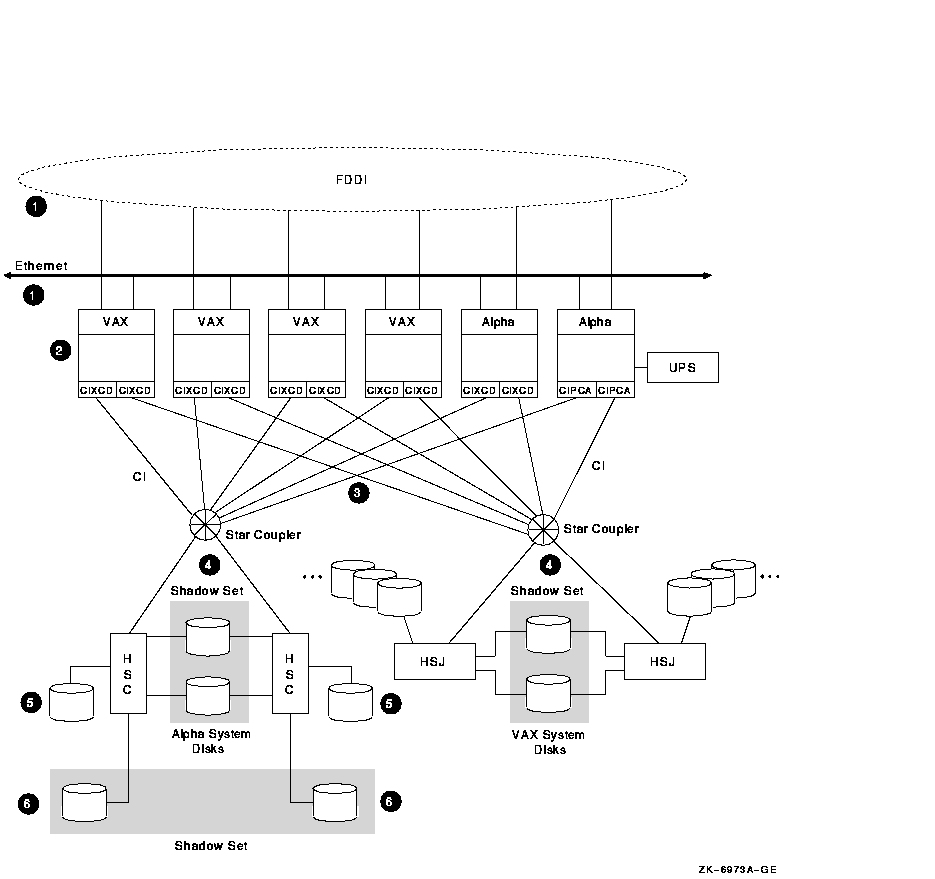
8.8.1 Components
The CI OpenVMS Cluster configuration in Figure 8-5 has the following
components:
| Part |
Description |
|
1
|
Two LAN interconnects.
Rationale: The additional use of LAN interconnects is
required for DECnet--Plus communication. Having two LAN
interconnects---Ethernet or FDDI---increases redundancy. For higher
network capacity, use FDDI instead of Ethernet.
|
|
2
|
Two to 16 CI capable OpenVMS nodes.
Rationale: Three nodes are recommended to maintain
quorum. A CI interconnect can support a maximum of 16 OpenVMS nodes.
Reference: For more extensive information about the
CIPCA, see Appendix C.
Alternative: Two-node configurations require a quorum
disk to maintain quorum if a node fails.
|
|
3
|
Two CI interconnects with two star couplers.
Rationale: Use two star couplers to allow for
redundant connections to each node.
|
|
4
|
Critical disks are dual ported between CI storage controllers.
Rationale: Connect each disk to two controllers for
redundancy. Shadow and dual port system disks between CI storage
controllers. Periodically alternate the primary path of dual-ported
disks to test hardware.
|
|
5
|
Data disks.
Rationale: Single port nonessential data disks, for
which the redundancy provided by dual porting is unnecessary.
|
|
6
|
Essential data disks are shadowed across controllers.
Rationale: Shadow essential disks and place shadow set
members on different HSCs to eliminate a single point of failure.
|
|




